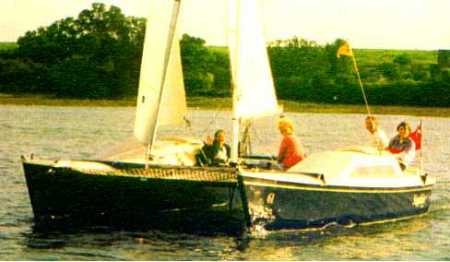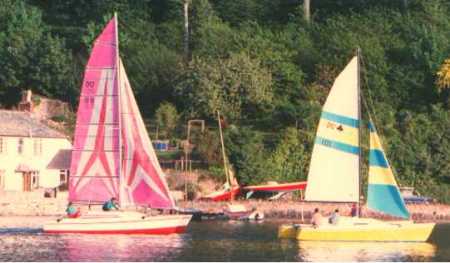Articles
Strider Sailing Photos

These are the boys who "star" in the building photos. A bit older now, seen on a sailing trip down to the Florida Keys

And this is the boat they are sailing on

This was our own grp Strider in which we won the 1987 UK and European multihull championships. It was the first to be fitted with a 10m tall racing rig and wider beams.
When we sold it the new owner said it made a good fishing platform - not bad for an ex racing boat!I last sailed it in 2012 in the UK Lake District where it is available for day charters - see the 2012 review pages

Five years later we bought a pair of used Strider hulls and re-rigged it with a smaller "F1" rig, the same size as the big rig Strider Club (Shadow). We called the boat Striderman and raced it in 1992 in the UK multihull championships.
We finished third overall (despite the fact that my crew had never sailed a catamaran before, nor used a spinnaker) Fourth overall was Rodney Pattinson who had one two gold and one silver Olympic medals and was sailing a F24. We beat him over the line in every race except one.

The standard Strider has dinghy style kick up rudders, but when we built Striderman we used the kick up semibalanced rudders that we also use on our bigger designs (Sagitta, Eclipse, Banshee etc). This rudder design gives more positive steering, but is not possible to steer with the rudders in the up position. Drawings are available on request.

This photo was taken as we sailed through the lee of a Dragonfly trimaran, who's owner later told us he was sailing at 18 knots. Note the lack of spray
Although the boat used standard grp hulls, by paying careful attention to weight throughout the fit out, Striderman was 150kgs lighter than the next lightest Strider. We used the motto "if in doubt leave it out", hence no windows, a wire mainsheet horse, no outboard, etc etc. It resulted in a successful, cheap project and gave us a lot of fun that year.

A Strider moored next to a 27ft Surfsong in the S Pacific

Sapphire was one of the best grp Striders. She won the 1989 UK National Championships and also trailed from the UK to races in Italy

Another good Strider is Tigger, which for several years was sailed very hard and won a good number of races in the UK often beating larger boats boat-for-boat. For example: "First to finish the full 23.2 mile course at 1316 was Ben Goodland’s Strider 24 catamaran Tigger, followed by a tight battle between two trimarans, George Burn’s Farrier F27 Smokey Bear and Simon Forbes’ Dragonfly 800 Scooby III and in fourth place Grant Kelly’s F27 Beatus."


There are several options for engine installation. We recommend a 4hp Mariner or Yamaha long shaft. It can be mounted on a bracket off the aft beam (thus keeping the cockpit clear) as shown here, or in a well in the cockpit (for easier engine access). Expect about 6 knots cruising speed.

The grp Striders used aluminium beams (6" dia). Wooden Striders can use wood box beams or aluminium

Its very easy to sail any multihull with a spinnaker as no pole is required. The sail is simply tacked down to the windward bow and sheeted as normal from the lee stern

This colourful Strider is sailing in Malta

And this is a wood one sailing in Wales, not the Crayfish dinghy on the foredeck

Sailing is much more fun if the whole family can enjoy being on the boat. That often means being able to dry out on a beach so that children can play in the sand.

With its shallow draft its easy to board a Strider when its dried out. Although you do have to be careful about rocks, the lack of keels does make it easier to board when compared to a Strider Club which has the same hulls, but LAR keels instead of daggerboards.

Note the dinghy style kick up rudders and the conventional tent on deck

We built Woods Express in 1998 as an experiment in lightweight building. Expecting it to last one season, it is still sailing 12 years later. There was only 60kgs of glass used in the whole boat. Two people could lift a hull. All up racing weight, including safety gear etc was 580kgs (a Firebird weighs around 720kgs a Dragonfly 1100kgs).
It was extremely quick in light winds, in fact we beat all Firebirds and Dragonflies in its first race. Unfortunately Richard then fell off the boat while moving it in the marina and severely gashed his leg and we weren't able to race it properly again.
(The following year we sailed the Strider Clubs to the USSR)

Woods Express, a Strider Turbo, sailing next to a Strider Club in Millbrook. The difference in rig size is very obvious! The Strider Turbo is only suitable for experienced sailors who want to race. A fleet of Turbos are sailed in Zimbabwe.

This Strider is really being pushed to its limits (racing in a F7). We would recommend reefing a bit more before it got this windy!!

This was the first grp Strider and was built for Mark Orr. Mark is a very tough sailor and raced in the 3 Peaks Race (he broke the record on one leg) as well as cruised many miles singlehanded (eg Plymouth to Holland). He also came 3rd in the 1985 Micromultihull World Championship. See the Articles pages for more

These photos is a grp Strider. There is very little difference between the grp and wood versions. About 40 grp boats were built between 1984 and 1990. Raised daggerboards can be clearly seen. This boat had an optional forward netting beam and hatches over the front bunks. Black is not recommended as a hull colour!
It is also possible to add a small cuddy to a Strider, as has been done on Merlin and Janus. The Welsh Strider, above, was converted to a cuddy version after a few years as an open deck boat


The Strider is easy to trail, especially if a telescopic trailer is used. One person can then assemble and launch the boat. Two people can do it in 45 minutes.










